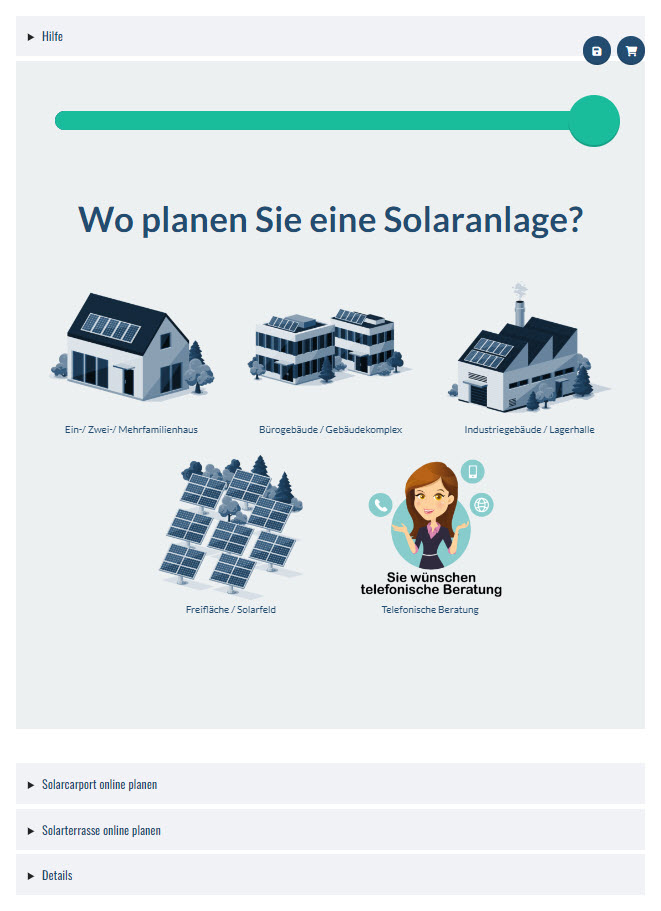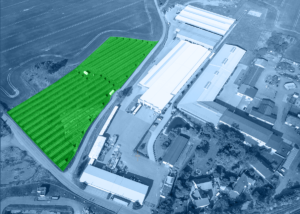City Solar Roofing - The Solar City Pergola with partially transparent solar modules, the ideal concept for the green smart city of the future
Published on: July 16, 2023 / Update from: July 16, 2023 - Author: Konrad Wolfenstein
Innovation in Shade Architecture: The Emerging Importance of Solar Pergolas
A pergola is a versatile and aesthetically pleasing structure used in both private gardens and public areas. It is usually made of wood or metal and consists of columns connected to each other by crossbeams. The open design allows light and air to flow through the pergola while providing shade and protection from direct sunlight.
An interesting further development of the pergola is the solar pergola, which integrates the use of solar energy into the structure. Similar to solar patios or solar parking lots, the solar pergola uses photovoltaic technology to convert solar energy into electrical energy. It can either be equipped with conventional solar modules or with special partially transparent, translucent solar modules. These transparent modules allow sunlight to partially shine through the pergola while generating energy at the same time.
In urban areas, larger pergolas are often built to beautify and functionally use public squares, pedestrian zones or parks. These large format pergolas can serve as shade canopies to protect passers-by from the sun or light rain. They offer a pleasant outdoor lounge that can be used to linger, relax or as a meeting place.
When it comes to integrating solar technology into pergolas, the idea of solar pergolas is still in its infancy compared to solar rooftop systems such as solar terraces or solar parking lots. However, the potential and possible expansion of this technology are promising. Using semi-transparent solar panels in solar pergolas could help generate renewable energy while adding aesthetic value and a pleasant outdoor living space.
Advances in solar technology and increasing demand for environmentally friendly solutions will lead to increased use of solar pergolas in cities. They are becoming an important part of the urban landscape by combining sustainable energy production and pleasant, shaded outdoor spaces.
Solar pergolas therefore offer an exciting opportunity to generate renewable energy while providing aesthetic and functional benefits. Integrating solar technology into pergolas opens up new ways to harness solar energy and reduce reliance on traditional energy sources.
The use of semi-transparent solar panels in solar pergolas is particularly interesting as they allow light to partially shine through the structure. This creates a pleasant and inviting atmosphere while generating solar energy. The semi-transparent solar panels can be designed to provide the desired level of light transmission and energy production without compromising the aesthetic quality of the pergola.
The solar pergolas can be used in various urban areas. They can be installed in parks and public spaces to provide visitors with shaded seating areas and renewable energy at the same time. Pedestrian zones and shopping streets could be equipped with solar pergolas to protect passers-by from sunlight and at the same time visually enhance the streets and sidewalks.
Another interesting aspect of solar pergolas is their potential role in promoting electric mobility. By integrating charging stations for electric vehicles into the pergola structure, solar pergolas can become sustainable energy hubs. Visitors could park their vehicles under the pergola (solar carport/solar parking lot) and at the same time use clean energy to charge their vehicles. This would encourage the use of electric vehicles and help reduce CO2 emissions.
However, to realize the full potential of solar pergolas, several challenges still need to be overcome. This includes optimizing the energy production efficiency of the semi-transparent solar modules, integrating energy storage solutions and taking planning and approval procedures into account in urban environments. Nevertheless, initial pilot projects and research show that solar pergolas are a promising technology that can help make cities more sustainable and energy efficient.
➡️ Solar pergolas are an interesting way to harness solar energy while creating attractive and functional outdoor spaces. Thanks to their versatility and potential, they can make an important contribution to the implementation of sustainable urban development strategies and the promotion of renewable energies. With further research and development, solar pergolas could become a more common feature in our urban landscapes in the near future.
Optimization of the planning and installation of AC/DC or pure DC-side systems - Our comprehensive service for cities, municipalities, companies and external partners
More about it here:
Plan your solar system for the most common applications conveniently online with our solar system planner!
With our user-friendly solar system planner you can plan your individual solar system online. Whether you need a solar system for your home, your business or for agricultural purposes, our planner offers you the opportunity to take your specific requirements into account and develop a tailor-made solution.
The planning process is simple and intuitive. You simply enter relevant information. Our planner takes this information into account and creates a tailor-made solar system that meets your needs. You can try out different options and configurations to find the optimal solar system for your application.
Additionally, you can save your plan to review later or share with others. Our customer service team is also available to answer your questions and provide support to ensure your solar system is optimally planned.
Use our solar system planner to plan your individual solar system for the most common applications and advance the transition to clean energy. Start now and take an important step towards sustainability and energy independence!

The solar system planner for the most common applications: Plan the solar system online here - Image: Xpert.Digital
More about it here:
Solar potential: How building-integrated photovoltaics is changing our cities
From solar pergolas to solar parking spaces: The diverse applications of GIPV technology
Building-integrated photovoltaics (GIPV) is an innovative technology that combines renewable energy production with urban architecture. It makes it possible to seamlessly integrate solar modules into the building structure and opens up a wide range of applications such as solar pergolas, solar terraces and solar parking spaces.
Solar pergolas are structures that are equipped with solar panels and act as a roof. Not only do they serve as sun protection, but they also generate clean energy. Such pergolas are often used in parks, shopping centers or public spaces, where they not only contribute to the energy supply but also offer aesthetic added value.
Solar terraces are another form of GIPV and are used in buildings such as office complexes, residential buildings or hotels. Solar modules are integrated into the terrace surface, which means that the area of a terrace can be used to generate energy at the same time. Solar terraces therefore offer a smart way to generate renewable energy without requiring additional space.
Solar parking spaces are a particularly innovative application of the GIPV. They combine the need for parking spaces with the possibility of generating energy. The parking spaces are covered with solar panels so that they not only provide protection from the weather, but also produce clean energy. Such solar parking lots are often used in urban areas to meet the energy needs of surrounding buildings or to serve as charging stations for electric vehicles.
The integration of GIPV into urban architecture contributes to the development of smart cities and significantly changes the future of urban architecture. Smart cities are characterized by the integration of technology and data into city infrastructure to improve efficiency, sustainability and quality of life.
Similarities between GIPV and Smart City concepts lie in their pursuit of sustainability and the use of renewable energies. Both GIPV and smart cities promote the use of clean energy sources and help reduce greenhouse gas emissions. They also improve the energy efficiency of buildings and urban infrastructure.
Another common aspect is the integration of technology. Both GIPV and smart cities use innovative technologies such as sensors, intelligent control systems and real-time data to optimize energy production and consumption. This integration makes it possible to make energy production and distribution more efficient and to control energy consumption.
Differences between GIPV and Smart City concepts lie in their focus and scope of application. GIPV specifically focuses on integrating solar panels into the building structure to generate renewable energy. It offers solutions for energy generation using existing building areas such as pergolas, terraces and parking spaces.
Smart cities, on the other hand, encompass a broader range of concepts and technologies that aim to make cities more sustainable, efficient and livable. In addition to energy production, smart cities also include aspects such as intelligent traffic control, optimized waste management, connected infrastructure and digital services for citizens.
➡️ GIPV and Smart Cities share common goals such as sustainability and energy efficiency. However, while GIPV focuses on integrating solar panels into the building structure to generate renewable energy, smart cities encompass a broader range of concepts and technologies that aim to holistically transform cities and improve people's quality of life.
Building-integrated photovoltaics: solar pergolas, solar terraces and solar parking spaces in comparison
From shade-providing pergolas to energy-generating parking spaces: the diversity of GIPV applications
Solar pergolas, solar terraces and solar parking spaces are various applications of building-integrated photovoltaics (GIPV) that differ in their functionality and area of application. However, there are also similarities between them, particularly in relation to their use of renewable energy sources and their contribution to sustainable development.
Solar pergolas are structures that are equipped with solar panels and act as a roof. They provide protection from the sun and the elements while generating clean energy. Solar pergolas are often used in public areas such as parks, squares or shopping centers. Not only do they serve as a source of energy, but they also provide added aesthetic value and create a pleasant space for the public.
Solar terraces, on the other hand, refer to the integration of solar panels into the surface of terraces in buildings such as office complexes, residential buildings or hotels. These solar panels serve as a source of energy and make efficient use of the available space. Solar terraces offer a smart way to generate renewable energy without creating additional space requirements. They can contribute to the power supply of buildings and thus reduce energy consumption.
Solar parking spaces are a particularly innovative application of the GIPV. In solar parking spaces, solar modules are installed as a roof over parking spaces. Not only do they provide protection from the elements, but they also generate clean energy. Solar parking lots are often used in urban areas to meet the energy needs of surrounding buildings or to serve as charging stations for electric vehicles. They use the available space efficiently and contribute to promoting electromobility.
The differences between the three applications lie mainly in their functionality and their area of application. Solar pergolas serve primarily as a roof and create a shady space for the public. They are primarily designed to generate renewable energy while providing added value in terms of aesthetics and comfort.
Solar terraces, on the other hand, are designed specifically for buildings and serve both to generate energy and to use the existing terrace space. They make it possible to generate renewable energy in residential and commercial buildings and reduce energy consumption.
Solar parking spaces have a dual function: they provide protection for vehicles and generate energy at the same time. They are often used in urban environments to make the most of limited space and improve energy supplies near buildings or transport hubs.
Despite these differences, solar pergolas, solar terraces and solar parking spaces also have similarities. All three applications use solar modules to generate energy and thus contribute to reducing greenhouse gas emissions. They are part of a sustainable infrastructure and promote the use of renewable energy in urban areas. In addition, they make efficient use of the available space and help improve energy efficiency.
➡️ Solar pergolas, solar terraces and solar parking spaces can be viewed as different solutions in the area of building-integrated photovoltaics. While solar pergolas serve as a roof and offer aesthetic added value, solar terraces enable the use of terrace areas to generate energy. Solar parking lots combine vehicle shelters with renewable energy production. Despite their differences, all three applications contribute to promoting sustainability and renewable energy in urban environments.
Where does pergola come from?
The word “pergola” originally comes from Italian and has its origins in the Latin term “pergula”. “Pergula” means “ledge”, “small roof” or “covered passage”. The Latin word “pergula,” in turn, is derived from the verb “pergere,” which means “to move forward” or “to go on.”
The pergola as a structure has a long history and was already known in ancient times. In ancient Rome, pergolas were used as shade canopies, often covered with vines or other climbing plants. They served as shady passageways or outdoor seating areas.
Over time, pergolas have evolved and become a popular architectural structure in gardens and outdoor spaces. Today, pergolas are often used as freestanding or attached canopies, made of wood, metal or other materials and often covered with climbing plants such as vines, roses or vines.
The pergola is known for its open structure that provides shade while creating an airy atmosphere. It is often used to design patios, garden areas or outdoor seating, providing a pleasant space to enjoy nature.
➡️ The correct plural form for “pergola” is “pergolas”. However, “pergolas” is also widely used colloquially.
Where are pergolas used in cities?
Pergolas are used in various urban areas to create a pleasant and shady outdoor environment. Here are some places where pergolas are commonly found in cities:
Parks and gardens
Pergolas are often used as structuring elements in public parks and gardens. They serve as shady passageways, seating areas or as canopies for playgrounds, relaxation areas or picnic areas.
Cafes, restaurants and bars
Many cafes, restaurants and bars in urban areas use pergolas to expand their outdoor space and provide additional outdoor space. Pergolas create a cozy atmosphere and protect guests from sun and light rain.
Pedestrian zones and shopping streets
Pergolas are often installed in busy pedestrian zones or shopping streets to provide shade and increase the comfort of passers-by. They also provide opportunities to hang hanging baskets or decorative elements to create an attractive environment.
City centers and squares
In some city centers and public spaces, pergolas are used as architectural elements to create seating, meeting points or viewing points. They can also be used as part of art installations or temporary events.
schools and universities
Educational institutions sometimes use pergolas to create outdoor spaces such as courtyards or break areas. They offer students a shady space to relax, study or engage in social activities.
Urban residential areas
In some residential areas or condominiums, pergolas are used as private patio covers or carport covers. They create shaded outdoor areas for residents and provide shelter for vehicles.
➡️ These are just a few examples of the use of pergolas in urban areas. The versatility of pergolas allows them to be used in many locations around the city to provide shade, aesthetics and a pleasant outdoor atmosphere.
The Solar City Pergola: Aesthetic design and clean energy for a city worth living in
Solar City Pergola: Combining shade and solar energy in the smart city for green urbanization
The green smart city concept relies on sustainable and environmentally friendly solutions to make cities more efficient, more livable and energy self-sufficient. An important part of this concept is the integration of solar energy. The Solar City Pergola plays an important role as an urban solar roof.
The Solar City Pergola is an innovative solution that seamlessly integrates solar panels into urban areas while providing shade. It combines function and aesthetics by creating a pleasant and shady environment while generating clean energy.
The Solar City Pergola is used in various urban areas and offers numerous advantages. In parks and gardens it serves as a covered seating area or shady passage. The integrated solar modules generate electricity that can be used to light paths, water plants or operate playgrounds. This combination of functionality and sustainable energy production contributes to the environmentally friendly design of public green spaces.
In urban pedestrian zones and shopping streets, the Solar City Pergola not only offers protection from sun and rain, but also generates energy that can be used for lighting or running shops. It therefore creates a pleasant and energy-efficient environment for pedestrians and promotes a sustainable shopping experience.
The Solar City Pergola also plays an important role in city centers and squares. It can serve as a covered meeting place while also providing energy for plaza lighting or art installations. This combination of architecture, energy production and public space creates an attractive and sustainable environment for the city's residents and visitors.
In addition, schools and universities can benefit from the Solar City Pergola. It provides shaded areas for outdoor students, while the solar panels can provide electricity to power classrooms, laboratories or other facilities. This not only promotes a sustainable educational environment, but also serves as an example of renewable energy and environmental awareness.
The Solar City Pergola can also play an important role in urban residential areas. It can serve as a roof for private patios or carports while providing clean energy for residents. This contributes to the energy self-sufficiency of residential areas and enables residents to generate and use their own electricity.
The Solar City Pergola is therefore a central element of the solar concept for the green smart city. It combines sustainable energy production with urban design, creating pleasant and functional urban areas. By integrating solar panels into the pergola, the Solar City Pergola becomes an innovative solution to meet the city's energy needs while creating a green and livable environment.
- Warehouses, production halls and industrial halls with their own power source from a photovoltaic roof system - Image: NavinTar|Shutterstock.com
- Industrial plant with its own power source from an outdoor photovoltaic system - Image: Peteri|Shutterstock.com
- Plan solar systems with photovoltaic solutions for freight forwarding and contract logistics
- B2B solar systems and photovoltaic solutions & advice
- Plan photovoltaics for warehouses, commercial halls and industrial halls
- Industrial plant: Plan a photovoltaic open-air system or open-space system
- Plan solar systems with photovoltaic solutions for freight forwarding and contract logistics
- B2B solar systems and photovoltaic solutions & advice
From simple solar roofing to large-scale projects: with Xpert.Solar, your individual solar system advice
I would be happy to serve as your personal advisor.
You can contact me by filling out the contact form below or simply call me on +49 89 89 674 804 (Munich) .
I'm looking forward to our joint project.
Xpert.Digital – Konrad Wolfenstein
Xpert.Digital is a hub for industry with a focus on digitalization, mechanical engineering, logistics/intralogistics and photovoltaics.
With our 360° business development solution, we support well-known companies from new business to after sales.
Market intelligence, smarketing, marketing automation, content development, PR, mail campaigns, personalized social media and lead nurturing are part of our digital tools.
You can find out more at: www.xpert.digital – www.xpert.solar – www.xpert.plus































